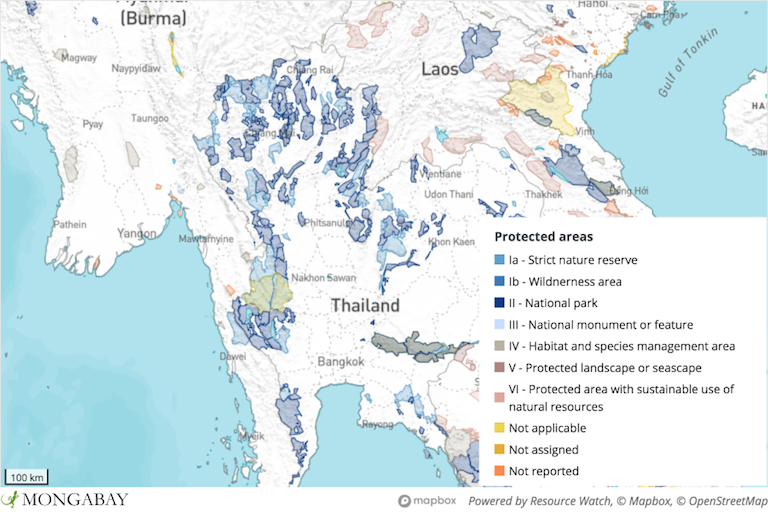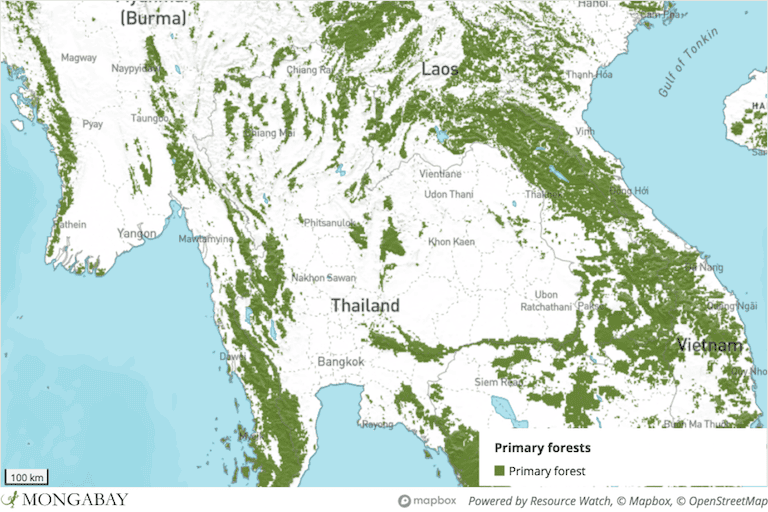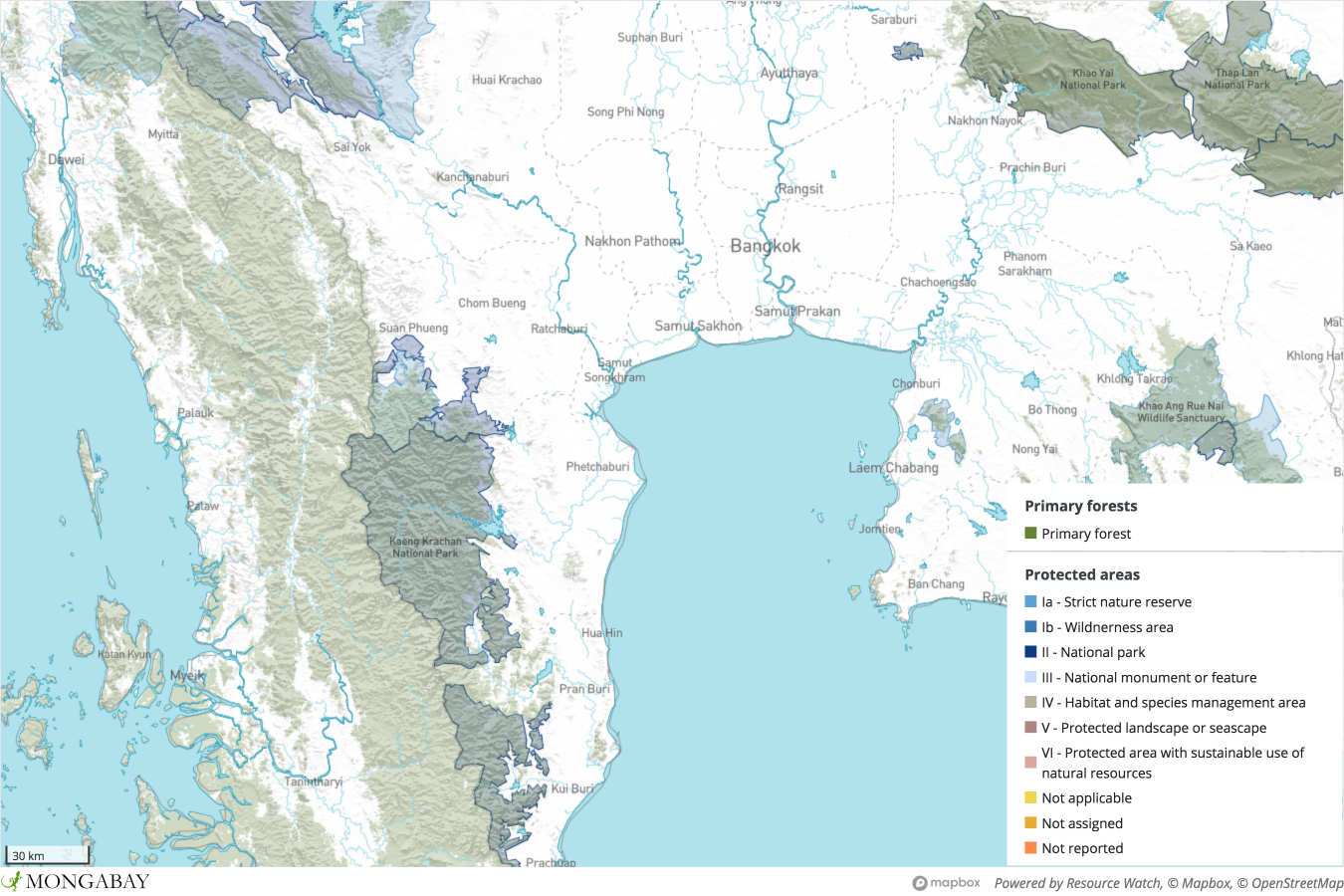- Straddling the Myanmar-Thai border, the Dawna Tenasserim Landscape (DTL) is the intersection of four different biogeographic zones and consequently supports rich species diversity.
- The ecosystem is particularly important for the survival of Southeast Asia’s big cats, including the Indochinese tiger.
- Large, wide-ranging species like tigers require connected networks of forests to move and disperse through; the species cannot thrive in isolated pockets of protected forest.
- Efforts to protect tigers in the DTL highlight the need for cross-border efforts to maintain ecosystem connectivity.
Big cats require big home ranges. In February 2016, a young male Indochinese tiger (Panthera tigris corbetti) walked from Huai Kha Khaeng Wildlife Sanctuary in western Thailand to Kayin state in Myanmar. After crossing mountains, rivers, roads and national borders over the course of its 170-kilometer (105-mile) journey, he ventured out of the forest into a wetland, where he was shot dead following conflict with people.
The tragic tiger’s journey highlights how the arbitrary lines of national borders are nonexistent for wildlife. It also underscores that the fate of wildlife in the region ultimately depends on conservation actions on both sides of the border: in Thailand, where remaining tracts of natural forest are safeguarded through formalized protected areas; and in Myanmar, where a history of armed conflict and contested land rights have left many forested areas vulnerable and unprotected, and where a Feb. 1 military coup threw conservation plans further into question.
Huai Kha Khaeng Wildlife Sanctuary, where the tiger’s ill-fated journey began, is part of Thailand’s Western Forest Complex (WEFCOM), a 1.87-million-hectare (4.62-million-acre) network of 17 national parks and wildlife sanctuaries that borders Myanmar. The complex harbors Southeast Asia’s largest breeding population of tigers as well as six other cat species, including Indochinese leopards (Panthera pardus delacouri) and clouded leopards (Neofelis nebulosa). It is a critical stronghold for big cats, from which individuals can disperse to replenish threatened populations in neighboring regions.
Conservationists now recognize that large, wide-ranging species need more than isolated protected areas to maintain genetically viable breeding populations. Species like tigers require connected networks of safe forests that allow them to move and disperse across landscapes, maximizing populations’ genetic diversity and adaptability to climate change and other ecological disturbances.
In other words, the long-term survival of tigers and other big cat species in Thailand and Myanmar depends on their ability to travel safely outside of breeding strongholds like WEFCOM.


WEFCOM lies within a much larger forested ecoregion called the Dawna Tenasserim Landscape (DTL), which encompasses 18 million hectares (44.5 million acres) between Thailand and Myanmar. It is the intersection of four different biogeographic zones and consequently supports rich species diversity. According to WWF, six of the seven cat species present in WEFCOM were recorded in the Myanmar part of the DTL during mid-2019 camera-trapping studies. Maintaining forest connectivity throughout the DTL is a now primary conservation focus in the region.
However, the remaining intact forests in the DTL are spread out on both sides of the border, and potential corridors that zigzag between them are being eroded by piecemeal infrastructure projects and land clearance for agriculture. Big cats also face the ever-present threat of poaching for the illegal wildlife trade and prey depletion by human hunting.
According to Tim Redford, program director at Freeland, an NGO that has been studying big cats in the region for more than two decades, “the biodiversity of the Dawna Tenasserim Landscape is absolutely incredible.” He says that since tigers require vast expanses of intact forest, measures taken to protect tigers would also benefit countless other species.
“The Indochinese tiger has been declining rapidly, having been lost in Laos, Cambodia and Vietnam over the last couple of years or so,” Redford says. The Myanmar tiger population is vulnerable, and action is needed now to ensure that it doesn’t go extinct there too. Figures released by the Myanmar government in 2019 estimate the number of remaining tigers at 22 individuals, based on surveys in just 8% of potential tiger habitat across the country. Even though this figure is likely an underestimate of the total population, experts agree that the situation for Myanmar’s tigers is precarious.
“In parts of Myanmar with no current breeding evidence of tigers, populations are on a knife-edge,” says Demelza Stokes, project manager at Wildlife Asia, an Australian NGO that coordinates the Karen Wildlife Conservation Initiative (KWCI). “If important forest corridors get severed, then the chances of tigers rebounding in these areas will plummet.”

Dispersal from strongholds
Work is now underway to understand and address the factors that limit the size of big cat populations and their dispersal out of strongholds like WEFCOM.
A recent study in the Journal for Nature Conservation reported that tiger prey species — large wild ungulates such as sambar deer (Rusa unicolor) and banteng (Bos javanicus) and gaur (Bos gaurus) wild cattle — have been depleted by poaching and habitat fragmentation in WEFCOM. Occupancy models showed that gaur and sambar are present in just 28% and 50% of suitable habitat respectively, and banteng, in line with trends across Southeast Asia, have been extirpated from all areas outside of Huai Kha Khaeng World Heritage Site. The study suggests that even in areas of WEFCOM with well-protected intact forest, the tiger population can grow no further due to lack of prey.
To boost big cat prey populations within WEFCOM, local NGOs are engaging communities to alleviate pressures on large ungulates, and the Department of National Parks, Wildlife and Plant Conservation (DNP) is piloting the reintroduction of banteng in several wildlife reserves.
Poaching of big cats in Thailand’s protected areas is comparatively rare, according to Regan Pairojmahakij, Dawna Tenasserim transboundary landscape manager at WWF. She attributes this to the SMART patrol efforts of the DNP. “Thailand has done an excellent job with protected area complexes which allow the scope of land required for maintaining populations of big cats,” she says.

Nonetheless, outside of Thailand’s formal protected areas, land has been widely converted from natural forest to agriculture, infrastructure and residences. Therefore, crucial habitat corridors between protected area complexes are fragmented, impeding dispersal of big cats out of breeding strongholds like WEFCOM into other intact forests. This can result in under-population of prime forest habitats. For example, Kaeng Krachan Forest Complex, home to Thailand’s largest national park, has very few tigers despite being just 75 km (47 mi) south of WEFCOM.
Such intense land use outside of protected areas in Thailand means efforts to preserve forest connectivity can only go so far. In some cases, remaining safe forest corridors traverse the international border into Myanmar. A study published in Global Ecology and Conservation in December 2020 found that clouded leopard strongholds in Thailand’s protected areas — the Western Forest Complex, Kaeng Krachan National Park, and Khlong Saeng-Khao Sok Forest Complex — are only connected to one another via vulnerable forest corridors on the Myanmar side of the border. According to the authors, urgent action is required to improve Myanmar’s protected area networks so that such wildlife corridors are preserved.

However, intact forest landscapes in Myanmar are disintegrating under the pressure of a development boom. Conservationists are particularly concerned about a slew of pipelines and roads, some of which are transboundary, that threaten to carve up the landscape. A primary concern is construction of a 138-km (86-mi) highway to link the special economic zone in southeast Myanmar’s port city of Dawei with southwest Thailand. The highway will bisect the important ecological corridor that connects WEFCOM with big cat habitats to the south, including Kaeng Krachan Forest Complex.
“[The highway] will form a solid linear barrier that will be impossible for wildlife to cross,” says Redford from Freeland. “Gradually over the next two to three years as these roads are built, there will be just chunks of the Dawna Tenasserim left, and it’s well documented how fragmentation hastens extinction.”
A 2019 report from WWF underscores what is at stake if the Dawei road bisects the ecological corridor without paying heed to mitigation measures. Camera-trap surveys recorded less wildlife near the highway route, where access road construction has begun, and picked up more encounters with hunters and dogs. The report suggests that “the road is likely to facilitate illegal hunting of wildlife by improving access to high-quality forest habitat.” According to WWF, prior work that outlined key wildlife crossing sites along the highway route to guide planning and mitigation measures has been incorporated into the road design. It remains to be seen whether the measures will be implemented.
Forest corridors along the Myanmar-Thailand border are also rapidly being eroded by corn farming. “What we are seeing increasingly is the loss of connectivity between key tiger heartlands on either side of the border as maize production fragments these zones,” Pairojmahakij says. “Often it is core forest that is being lost.”

Forests need better protection
The need for effective forest protection in Myanmar is clear. Not only are the threats to long-term survival of big cat populations transboundary in nature, but dispersal routes into the DTL and between Thailand’s protected areas depend on forest continuity on both sides of the border. Nonetheless, while Thailand’s national forest policy calls for restoration — at least on paper — deforestation continues in Myanmar at one of the highest rates in Southeast Asia.
Myanmar had around 40.1 million hectares (99 million acres) of natural forest in 2010, occupying 61% of its land area, according to Global Forest Watch. Between 2002 and 2019, more than 577,000 hectares (1.4 million acres) of primary forest were lost, primarily due to agriculture, logging and other human activities. This represents a 4% decrease in primary forest cover in 18 years.
The protected area system in Myanmar lags behind those of neighboring countries. This is largely attributable to reduced institutional capacity following decades of armed conflict. Prior to the Feb. 1 military takeover, the civilian-led government had taken steps toward democratic reforms, but state-driven policies continued to suffer from lack of appropriate engagement with ethnic groups and civil society. The re-imposition of direct military rule threatens to complicate conservation efforts further.
In southeast Myanmar, the regions bordering Thailand’s WEFCOM are populated largely by Karen Indigenous communities, hundreds of thousands of whom were displaced to camps along the Thai border during the civil war. Long-standing conflict rendered large tracts of Karen forests inaccessible for many years, providing refuge for diverse wildlife. Surveys by KWCI in Karen (Kayin) state in 2017 found 31 species of mammals, including tigers, Asian elephants (Elephas maximus), Phayre’s langurs (Trachypithecus phayrei) and dholes (Cuon alpinus).

Community empowerment boosts forest protection
If conservation in the Dawna Tenasserim Landscape is to succeed, the authorities need to be able to engage with communities living in the area, experts say.
“Community empowerment is vitally important to implementing sustainable conservation projects,” says Stokes from Wildlife Asia. “Local communities are the best stewards of their environment when they are empowered and included in steering initiatives from the beginning. In Myanmar, access to and respect for basic human rights, including land rights, is just a starting point for protecting people and wildlife from exploitation and industrial expansion. The Salween Peace Park is an amazing example of this.”
Launched in December 2018, the Salween Peace Park is a Karen-led protected area encompassing 546,000 hectares (1.35 million acres) of largely intact teak forest west of the Salween River in southeast Kayin state. It is the culmination of several decades of community-driven approaches to conservation, such as the establishment of community forests, the enforcement of fish conservation zones and the demarcation of Kaw (traditional Indigenous lands). A total of 348 villages are included, comprising 27 community forests and three wildlife sanctuaries that are managed through Indigenous practices. The peace park initiative is driven by the Forestry Department of the Karen National Union (KFD) together with local Karen communities and the Karen Environmental and Social Action Network (KESAN).
Paul Sein Twa, co-founder of KESAN, was recently awarded the 2020 Goldman Environmental Prize for his work to establish the park, which adjoins the Salween Forest Complex across the border in Thailand. “The long-term goal of the Salween Peace Park goes beyond just wildlife conservation to include preservation of culture and a vision for peace and self-determination of indigenous people over our territory,” he told Mongabay on Jan. 18, shortly before the coup. “We have to preserve our heritage for future generations.”
KESAN supports communities in the Salween Peace Park to live in balance with nature in line with Karen animist beliefs. “Many endangered species, including tigers, are considered guardian spirits of the forest and are protected from hunting or killing by traditional taboos and prohibitions,” Sein Twa says. Raising awareness of such traditional hunting practices and cracking down on poaching through ranger patrols and community engagement are central to big cat protection in the park.

Preliminary surveys confirm the presence of several big cat species within the park. According to Evan Greenspan, science and research manager at KWCI, there is “evidence of breeding leopard populations among a number of recently surveyed forested areas. Given their rarity and population declines throughout much of the rest of Southeast Asia, the Salween Peace Park may host one of the last remaining healthy populations anywhere in the world.” Now, the KFD and KWCI are mapping important big cat forest corridors that maintain connectivity between the park and protected areas in western Thailand to inform habitat protection plans that incorporate Karen customary land practices and beliefs.
Sein Twa says he hopes the Salween Peace Park’s success will inspire a transition from top-down approaches to conservation. In the past, state-governed protected areas risked serious violations of Indigenous people’s rights; the Salween Peace Park offers a grassroots alternative that is garnering attention from like-minded communities in Myanmar.
According to Sein Twa, the most effective way to protect and conserve big cats across the wider landscape between Myanmar and Thailand is a combination of approaches that span grassroots to governmental levels. The Indigenous-led conservation model showcased in the Salween Peace Park can be rolled out to neighboring areas to create continuity with state-governed protected areas in both countries.
Advocates say they hope that tigers and other big cats can become a galvanizing force in this politically complex region. “Everybody has an interest in seeing the preservation of tigers in the landscape — nobody wants to lose them,” says WWF’s Pairojmahakij. “Whereas it would normally be difficult to bring stakeholders round the table to discuss issues such as transboundary conservation, tiger conservation could provide a catalyst to cooperation.”

FEEDBACK: Use this form to send a message to the author of this post. If you want to post a public comment, you can do that at the bottom of the page.
